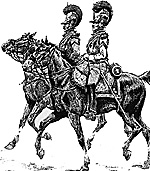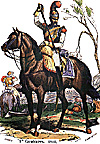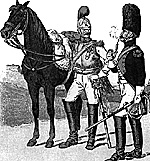The Carabiniers were among the oldest cavalry of the French army. Their origin goes back to the Ancien Regime. At that time they were a kind of light cavalry armed with a rifle, which is called in French carabine, hence their name Carabiniers. In the Royal army, the name Carabins was given to certain horsemen of the Light Cavalry equipped with the carabine.
In 1691, Louis XIV reorganized the carabiniers into one company per cavalry regiment. The carabinier company was always at the head of the regiment, which was the basis in 1791 to classify the Carabiniers at the head of all the cavalry. They were considered an elite corps.
Over the years, the Carabiniers went through several reorganizations to re-emerge during the Wars of the French Revolution and of the Empire as heavy cavalry, still two regiments strong, after exchanging their carabines for a musket [1] and adopting the bearskin in 1791.
During these campaigns, they had acquired a high reputation of their own and were more or less considered the Grenadiers of the cavalry. In 1806, Napoleon, who had thought very highly of them, appointed his brother Louis as Colonel-General of the 1st regiment and his brother-in-law Prince Borghese as Colonel.
The Carabiniers demonstrated their mettle at Austerlitz and during the Campaign of 1809 at Eckmuhl where they charged - after firing their muskets - the Austrian heavy cavalry. They were also at Ratisbon, Essling and Wagram.
Picture: The Carabiniers, by Job. However, during the Campaign of 1809, they suffered heavy casualties. The Manuscrit des Carabiniers, published in 1874, tells us that the Emperor in 1809, witness of their brilliant charges, took notice that many Carabiniers had head wounds because their bearskin simply fell off during the combat and consequently offered no protection whatsoever. Shortly after that Napoleon decided to provide them with a helmet and to transform them into some kind of cuirassiers, very likely in order to provide all of his heavy cavalry with the cuirass.
Their new uniform is shown on the color plate of a trooper on a blackhorse by Philippoteaux. The helmet is of a very special design, [2] made of brass with riveted front and rear visors, trimmed silver. It is held in place by silver chin scales pivoting on a like colored radial design with a small golden star in the center. The crest had a red caterpillar plume. Around the helmet was white metal trim with a golden crowned "N" in front.
The uniform, the habit-veste, which was originally planned to be red madder, is white with sky-blue turnbacks trimmed white with a grenade. The cuffs were red for the 1st regiment and sky-blue for the 2nd, both trimmed white. Hence it was impossible to tell apart the two regiments when the standard white gloves were worn by the troopers. The cuffs-flaps were white with sky-blue trim for the 1st regiment and sky-blue with white trim for the 2nd. Red epaulettes completely trimmed white rounded out the uniform.
The breeches, made of tan leather, were worn tucked into the black-leather, stiff-topped boots. Some gray cloth breeches, reinforced by leather in those portions in contact with the saddle, were also worn along with culottes hongroises, etc.
The full cuirass, made of steel covered with copper, is bordered by white metal with copper rivets and lined with darkblue cloth trimmed white. The back and front cuirasses are tied together over the shoulder by brass double chains underlayed with brown leather and at the waist by brown leather buckles.
A tan leather bandolier trimmed white with buckles and a musket hook of white metal was worn over the left shoulder. The saber of the Year XI pattern and a tan bayonet scabbard were suspended on a tan leather belt held by yellow metal buckle with a leaf design. The equipment was completed by a black leather cartouche with a grenade of yellow metal centered on the flap.
The armament, in addition to the saber, consisted of the cavalry musket [3] and two pistols of the Year XI pattern.
The great coat was white with skyblue lining along the inside of the front edge for the troopers and blue for the officers.
The NCO's had no cartouche, musket or bayonet. Their epaulettes were silver worked through with red strands.
The officers also had silver epaulettes, silver trim, shoulder binding silvered, ornate and underlayered with sky-blue.
The trumpeters wore a single breasted sky-blue habit-veste and a white plume for the 1st regiment and sky-blue for the 2nd. The epaulettes were white for the 1st regiment and red for the 2nd.
Both regiments were mounted on black horses and the trumpeters on greys.
Picture: The old and the new uniform of the Carabiniers. As can be seen, the bearskin was unwieldy for a cavalryman.(Lienhart & Humbert) [Editor's Note: The Revolutionary calendar commenced on September 22,1792. Year XI occurs between 1803-04.] Back to Empire, Eagles, & Lions Table of Contents Vol. 2 No. 10 This article appears in MagWeb (Magazine Web) on the Internet World Wide Web.


Notes
[1] The Carabiniers were armed with thecarabine in the Ancien Regime and firstpart of the Revolution. Jean Boudriot in Gazette des Uniformes, No. 35, p. 30, is ofthe opinion that the carabine was replacedby a musket or cavalry musket in the Year VII.
[2] Only two authentic helmets are knownto have survived and one of them isheavily damaged.
[3] The type of musket carried by the Carabiniers is uncertain.
Right: 1st Regiment of Carabiniers in 1812, by Philipoteaux.
Back to EEL List of Issues
Back to MagWeb Master Magazine List
© Copyright 1995 by Emperor's Headquarters
Other military history articles and gaming articles are available at http://www.magweb.com
